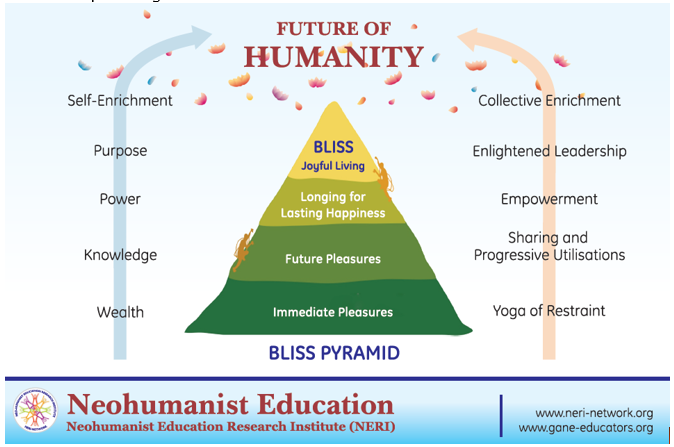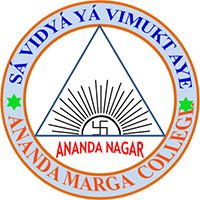Neohumanist Education
ANANDA MARGA COLLEGE

While Humanism extends the recognition of equal rights to all humans, Neohumanism, is instead the elevation of Humanism to Universalism, thus expanding an inclusive spirit of welfare to all living beings including Plants and animals. Studying about the “web of life” helps one to understand the interconnections between self, others and the natural environment. Neohumanist Education fosters love and respect for all, regardless of culture, religion, race or nationality, and for animals and plants and the earth’s ecosystems. Children learn these principles both through lessons and teacher modeling, as well as through developing their own intuitional feeling about the interconnectedness of all things. Its methodology is flexible, creative and culturally sensitive, making it adaptable to different cultures and parts of the world.
Aims and Ideals of Neohumanist Education
- To develop the full potential of each child: physical, mental and spiritual.
- To awaken a thirst for knowledge and love of learning.
- To equip students with academic and other skills necessary for higher education.
- To facilitate personal growth in areas such as morality, integrity, self-confidence, self-discipline and cooperation.
- To develop physical wellbeing and mental capabilities through yoga and concentration techniques, sports and play.
- To develop a sense of aesthetics and appreciation of culture through drama, dance, music and art.
- To encourage students to become active and responsible members of society.
- To promote an awareness of ecology in its broadest sense (i.e. the realization of the inter-relatedness of all things) and to encourage respect and care for all living beings.
- To encourage a universal outlook, free from discrimination based on religion, race, creed or gender.
- To recognize the importance of teachers and parents in setting an example.
Some General Principles of
Neohumanist Education

1. Integrated development of the whole personality -
Neohumanist Education facilitates the integral development of all aspects of the human personality: body, senses, intellect, imagination, intuition and spirit. It emphasizes not only the content of thought – the subject matter – but the very process of thinking itself, to develop methodical thought processes and creative intelligence. This provides a harmonious balance between academic learning, creativity and inner growth to awaken the highest potential in every child.
2. Value-oriented curriculum -
Universal moral values form the basis of an emotionally-balanced and discriminating individual life and a truly harmonious and cooperative human society. Neohumanist Education employs a comprehensive approach for imparting these values throughout all phases of school life and curriculum. The classrooms become moral communities in which the teacher serves as a role model, caregiver and mentor. Students deepen their own moral understanding through study and discussion, self-reflection, cooperative learning, conflict resolution and community service. This constant nurturing of moral values allows children to confront the moral challenges of today’s society and to grow into exemplary human beings who both respect and take responsibility for all members of their universal family.
3. Spiritual oneness as the goal of life -
The entire learning process is rooted in the conviction that the universe is an integrated whole in which everything is connected. In contrast to the separation and fragmentation that prevails in the contemporary world, the realisation of this oneness fosters a deep sense of connection to self, to others, and to all of life. Based on the current paradigm shift from a mechanistic, materialistic view of the universe to a new vision of wholeness and interdependence, the entire curriculum helps the students rediscover the meaning and purpose of existence. An education that values their inner, subjective world instills in students a profound respect for the mystery of life and a commitment to care for all creation.
4. Integrated approach to learning -
Instead of fragmenting knowledge into narrow and isolated academic disciplines, Neohumanist Education encourages the students in an active, multi-sensory and multi-disciplinary exploration of the world around them. Learning is a process, not a product: it is not merely an accumulation of objective facts, but rather seeing the world as a dynamic whole composed of a myriad of interrelated phenomena. Child-directed play in the early grades and self-chosen projects in later years stimulate a thirst for knowledge and a joy of learning which will remain with the children throughout their lives.
5. All disciplines -
The subtle expression of beauty in music, art, literature and other aspects of life uplifts the human mind and nurtures a deeply intuitional awareness of the oneness of all. This universalistic love for all created beings is the essence of Neohumanism. In Neohumanist Education, aesthetic appreciation and experience suffuse all aspects of learning. The classroom environment is aesthetically vibrant and integrated with artistic activity: painting, sculpture, drawing, music, dance, mime and drama. The curriculum also includes systematic training to develop the creative imagination of the right brain through fantasy, guided imagery and metaphoric thinking. This training not only develops the child’s creativity, but also enhances learning and academic performance and builds character by fostering a greater ability to empathize with others.
6. Blending of local culture and universal vision -
Neohumanist Education emphasizes the teaching of local languages and cultural traditions hand-in-hand with the inculcation of a universalistic outlook. Deepening our understanding of our culturo-linguistic heritage develops our strength of character, while ignorance or neglect of our cultural roots makes us vulnerable to suppression and exploitation. Neohumanist Education also fosters an appreciation of the magnificent diversity of human experience, for our diverse cultures form the flowers of the garland of a universal human society which transcends caste, creed, colour and race. Through a multicultural curriculum, students realize that this universe is all of ours; humans, animals, plants and the inanimate world. Only through such a universal outlook can we move collectively towards a global future of harmony and peace.
7. A new environmental consciousness -
Environmental education must not merely impart the values and skills necessary for responsible stewardship of our planetary resources (organic agriculture, waste recycling, renewable energy, land and water management, etc.); it must also help the children develop an intimate living relationship with the web of life around them. Through intensive study of the local area, with its complex cycles and interdependencies, the students will naturally replace linear and analytic thought processes with the synthetic cyclical thinking that is essential for a sustainable society of the future. A more subtle environmental education will develop an entirely new consciousness that experiences on the deepest level of being a sense of wonder at the beauty and harmony of the world and a feeling of kinship with all life.
8. Exemplary role of the educator -
In Neohumanist Education, the role of the teacher is of paramount importance, for teaching requires a subtle blending of intuitional insight, creative sensitivity, and scientifically grounded practices. Teachers must embody the noblest qualities of humanity: selflessness, strength of character, leadership and love for all life. They must constantly cultivate their own inner selves and therefore invite a co-learning, co-creating process with the students. They are the counselors and friends who treat each individual with special respect and affection. They facilitate the unfolding of the creative learning process by being attentive to the needs and abilities of each child. Teachers have the power to transform the students by their own example and loving guidance; to nurture the highest aspirations of the human spirit.
9. Inculcation of the spirit of service -
Neohumanist Education imparts a sense of responsibility to children: the sense that education is not a passport to privilege but a sacred responsibility to serve others. Thus the spirit of service is inculcated in the children from their earliest years by fostering a sense of compassion that makes them want to alleviate the suffering of others. Through loving and caring interactions with their surrounding bio-community, through service projects and stories, skill-development and self-discipline, they are encouraged to work not only for themselves but for all members of their universal family.
10. Social justice and upliftment -
Society in the true sense means individuals moving together towards a common goal, with no one lagging behind. Neohumanist Education encourages students to develop an awareness of social problems and equips them with the practical skills to solve them. They are thus inspired to work for social justice and for the upliftment of the neglected all over the world. A curriculum that liberates the intellect from dogmas and subtle forms of psychic exploitation instills in the students the conviction that change is possible and offers them the tools to create that change.
METHODOLOGY

Aims and Ideals of Neohumanist Education :
- To develop the full potential of each child: physical, mental and spiritual.
- To awaken a thirst for knowledge and love of learning.
- To equip students with academic and other skills necessary for higher education.
- To facilitate personal growth in areas such as morality, integrity, self-confidence, self-discipline and cooperation.
- To develop physical wellbeing and mental capabilities through yoga and concentration techniques, sports and play.
- To develop a sense of aesthetics and appreciation of culture through drama, dance, music and art.
- To encourage students to become active and responsible members of society.
- To promote an awareness of ecology in its broadest sense (i.e. the realization of the inter-relatedness of all things) and to encourage respect and care for all living beings.
- To encourage a universal outlook, free from discrimination based on religion, race, creed or gender.
- To recognize the importance of teachers and parents in setting an example.
For cognitive development :
- Acquiring knowledge in all spheres of life through analytical study and problem-solving, exploration and experimentation.
- Techniques to develop memory (repetition, association, visualisation and ideation), concentration, methodical thinking and rationality.
- Practical training in transforming psychic energy and enhancing positive thinking and self-esteem.
- Bio-psychological techniques to develop emotional equilibrium and higher order thought processes.
For moral development :
- Dramas, songs, moral dilemmas, games, stories and other literary forms to inspire a natural morality in the students.
- Moral examples of teachers of high integrity.
- Reinforcement of moral behaviour.
- Ethical values underlying all disciplines.
- Recitation of moral aphorisms.
- Ideational techniques by teachers and students to transform non-moral attitudes.
- Cooperative learning and conflict resolution.
- Creation of a moral community in the school.
For creative development :
- Training in the arts (music, theatre, painting, modelling, crafts, etc.) and their utilisation in all other disciplines to enhance learning.
- Use of fantasy through stories and drama.
- Techniques of metaphoric and lateral thinking.
- Training in visualization skills.
For intuitional and spiritual development :
- Elevating music, song and dance.
- Mind-expanding techniques of concentration and relaxation (‘quiet time’).
- Systematic exercises in deep-breathing and sensory withdraw.
- Concept of interconnectedness underlying curriculum design.
- Experiences of oneness with nature.
- Spiritual stories and dramas.
- Inspiration of the teacher.
For social and environmental development :
- Service projects in the local community.
- Lessons/discussions about social justice and human rights.
- Environmental excursions and campaigns.
- Inculcation of sense of responsibility through schools duties.
- ‘Child-to-child’ programs (children teaching other children).
- Vocational skills developed and applied in community service.
- Communication and group dynamics exercises.
- Leadership training

TO KNOW ABOUT NEO-HUMANISM CLICK HERE- https://neri-network.org/
TO KNOW ABOUT GURUKULA PROJECTS CLICK HERE- https://gurukul.edu/



